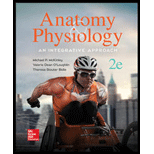
Which of the following is the correct circulatory sequence for blood to pass through part of the heart?
- a. right atrium → left AV valve → right ventricle → pulmonary semilunar valve
- b. right atrium → right AV valve → right ventricle → pulmonary semilunar valve
- c. left atrium → right AV valve → left ventricle → aortic semilunar valve
- d. left atrium → left AV valve → left ventricle → pulmonary semilunar valve
Introduction:
Homeostasis is maintained by continuous circulation of the blood in the body. Heart and blood vessels combine to make the cardiovascular system, where the circulation of blood takes place. The heart and blood vessels are organized into two types of circuits: the pulmonary circulation and systematic circulation.
Answer to Problem 1DYKB
Correct answer:
The correct circulatory sequence for blood to pass through part of the heart is right atrium
Therefore, option (b) is correct.
Explanation of Solution
Reason for the correct statement:
Option (b) is given as “right atrium
Hence, option (b) is correct.
Reasons for incorrect statements:
Option (a) is given as “right atrium
The blood of the right atrium is present on the right side of the heart, thus, it travels from the right, but not the left, AV valve. Hence, it is not correct.
Option (c) is given as “left atrium
The blood from the left atrium is present on the left part of the heart, thus, it moves from the left, but not the right, AV valve. Hence, it is not correct.
Option (d) is given as “left atrium
The blood from the left ventricles travels form the aortic, but not pulmonary, semilumnar valve. Hence, it is not correct.
Hence, options (a), (c), and (d), are incorrect.
Blood flows from the right side of the heart to the lungs to systematic cells of body and then back to the right side.
Want to see more full solutions like this?
Chapter 19 Solutions
Anatomy & Physiology: An Integrative Approach
- please fill in the empty sports, thank you!arrow_forwardIn one paragraph show how atoms and they're structure are related to the structure of dna and proteins. Talk about what atoms are. what they're made of, why chemical bonding is important to DNA?arrow_forwardWhat are the structure and properties of atoms and chemical bonds (especially how they relate to DNA and proteins).arrow_forward
- The Sentinel Cell: Nature’s Answer to Cancer?arrow_forwardMolecular Biology Question You are working to characterize a novel protein in mice. Analysis shows that high levels of the primary transcript that codes for this protein are found in tissue from the brain, muscle, liver, and pancreas. However, an antibody that recognizes the C-terminal portion of the protein indicates that the protein is present in brain, muscle, and liver, but not in the pancreas. What is the most likely explanation for this result?arrow_forwardMolecular Biology Explain/discuss how “slow stop” and “quick/fast stop” mutants wereused to identify different protein involved in DNA replication in E. coli.arrow_forward
- Molecular Biology Question A gene that codes for a protein was removed from a eukaryotic cell and inserted into a prokaryotic cell. Although the gene was successfully transcribed and translated, it produced a different protein than it produced in the eukaryotic cell. What is the most likely explanation?arrow_forwardMolecular Biology LIST three characteristics of origins of replicationarrow_forwardMolecular Biology Question Please help. Thank you For E coli DNA polymerase III, give the structure and function of the b-clamp sub-complex. Describe how the structure of this sub-complex is important for it’s function.arrow_forward
 Human Physiology: From Cells to Systems (MindTap ...BiologyISBN:9781285866932Author:Lauralee SherwoodPublisher:Cengage Learning
Human Physiology: From Cells to Systems (MindTap ...BiologyISBN:9781285866932Author:Lauralee SherwoodPublisher:Cengage Learning Medical Terminology for Health Professions, Spira...Health & NutritionISBN:9781305634350Author:Ann Ehrlich, Carol L. Schroeder, Laura Ehrlich, Katrina A. SchroederPublisher:Cengage Learning
Medical Terminology for Health Professions, Spira...Health & NutritionISBN:9781305634350Author:Ann Ehrlich, Carol L. Schroeder, Laura Ehrlich, Katrina A. SchroederPublisher:Cengage Learning
 Biology (MindTap Course List)BiologyISBN:9781337392938Author:Eldra Solomon, Charles Martin, Diana W. Martin, Linda R. BergPublisher:Cengage Learning
Biology (MindTap Course List)BiologyISBN:9781337392938Author:Eldra Solomon, Charles Martin, Diana W. Martin, Linda R. BergPublisher:Cengage Learning





